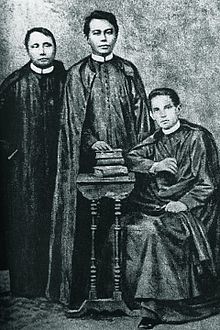Mariano Gomez (priest)
This article needs additional citations for verification. (February 2021) |
The Reverend Father Mariano Gomes | |
|---|---|
 An engraving featuring Fr. Gomes as the central figure, with him are Fr. Zamora on the left, and Fr. Burgos on the right. | |
| Church | Catholic Church |
| Personal details | |
| Birth name | Mariano Gómez de los Ángeles |
| Born | August 2, 1799 Santa Cruz, Manila, Captaincy General of the Philippines |
| Died | February 17, 1872 (aged 72) Bagumbayan, Manila, Captaincy General of the Philippines |
| Nationality | Filipino |
| Denomination | Roman Catholic |
| Parents | Francisco Gomez Martina Gomez (née Custodio) |
Mariano Gómes de los Ángeles[1] (Spanish: [ˈmaˈɾjano ˈɣomes]), often referred to by his original birth name Mariano Gómez de los Ángeles,[2] was a Filipino Catholic priest, who was falsely accused of mutiny by the Spanish colonial authorities in the Philippines in the 19th century. He was placed in a mock trial and summarily executed in Manila along with two other clergymen collectively known as the Gomburza. Gómez was the head of the three priests and spent his life writing about abuses against Filipino priests.
Early life[]
Gómez was born on August 2, 1799 in the suburb of Santa Cruz, Manila. He was a Tornatrás, one born of mixed Austronesian, Chinese and Spanish ancestries. His parents were Alejandro Francisco Gómez and Martina Custodio. After studying in the Colegio de San Juan de Letrán, he took theology in the University of Santo Tomás. He was a student preparing for the priesthood in the Seminary of Manila.
He was also the uncle of ilustrado nationalist and labor leader Dominador Gomez.[3]
Assignment in Cavite[]
On June 2, 1824, he was designated as the head priest of Bacoor, Cavite. Aside from taking care of the spiritual necessities of the town and the church, he also taught agriculture and cottage industries.[citation needed] Gómez also helped in maintaining a harmonious relationship among his other priests. He fought for equal rights for native priests against the abuses of their Spanish counterparts.
Name change from Gomez to Gomes[]
When Gomes took up parochial work, he discovered that he shared the name "Mariano Gomez" with a Spanish friar in Cavite and a priest from Cabuyao, Laguna. So he changed his last name from Gomez to Gomes, with the change from the letter "z" to the letter "s" meant to reflect is being "Tagalista," meaning he was proficient in the Tagalog language.[2]
As such, his name formally became "Mariano Gomes de los Angeles," and he signed his name "Mar Gomes de los Angeles." This was the name he officially signed in his last will and testament.[1]
Death[]
Gómez was accused of treason, sedition, and taking active part in the Cavite mutiny of 1872 and sentenced to death by garrote in a military court. He was sent to jail along with Joaquín Pardo de Tavera, Máximo Paterno, and the friars José Burgos and Jacinto Zamora. The three friars were executed on February 17, 1872 at Bagumbayan field; and have been known since then by the acronym composed of their collective surnames – Gomburza.
Before his death, Gómez was active in the publication of the newspaper "La Verdad" (Spanish, "The Truth").
At the age of 72, he was the oldest of the three priests.
In popular culture[]
- Portrayed by Victor Aliwalas in the official music video of GMA Network's production of Lupang Hinirang in 2010.
- Portrayed by Rommel Padilla in the 2014 film, Bonifacio: Ang Unang Pangulo.
See also[]
- Gomburza
- José Burgos
- Jacinto Zamora
- Cavite mutiny
References[]
- ^ Jump up to: a b Santiago, Luciano P.R., The Last Will of Padre Mariano Gomes. Philippine Studies Vol. 30, No. 3. Ateneo de Manila University
- ^ Jump up to: a b Gwekoh, Solomon Hilario (1974). Burgos-Gomes-Zamora : a first centennial biography Secular martyrs of Filipinism. Manila: National Book Store.
“When Gomes took up parochial work he became known by the name Mariano Gomes de los Angeles. This he did purposely in order to distinguish him from both a Spanish friar in Cavite and a priest from Cabuyao, Laguna, who were named Mariano Gomez. However, he signed his name as Mar Gomes de los Angeles. He chose to use the letter s in his family name isteaed of the Spanish letter "z" for being a Tagalista (an individual proficient in the Tagalog dialect [sic])”
- ^ Raquel A. G. Reyes (2008). Love, Passion and Patriotism: Sexuality and the Philippine propaganda movement, 1882-1892. NUS Press. p. 263. ISBN 9789971693565.
| Wikimedia Commons has media related to Mariano Gomez. |
- Zaide, Gregorio F. (1984). Philippine History and Government. National Bookstore Printing Press.
- Ignacio, Josefina O. (1979). Biographies of Filipino Heroes. Merriam-Webster, Inc.
- 1799 births
- 1872 deaths
- Executed Filipino people
- Colegio de San Juan de Letran alumni
- Filipino Roman Catholic priests
- Filipino people of Chinese descent
- Filipino people of Spanish descent
- People executed by ligature strangulation
- 19th-century executions by Spain
- People of Spanish colonial Philippines
- Catholic Church in the Philippines
- University of Santo Tomas alumni
- People from Santa Cruz, Manila
- Burials at Paco Park
- 19th-century Roman Catholic priests